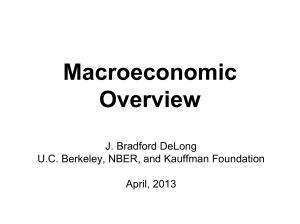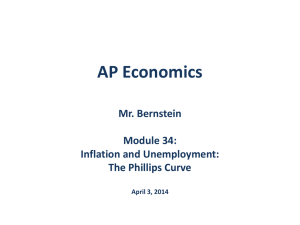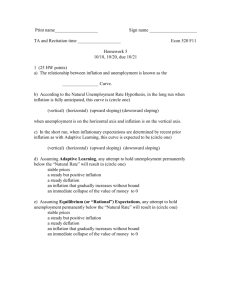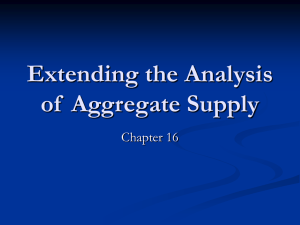Questions & Answers
advertisement
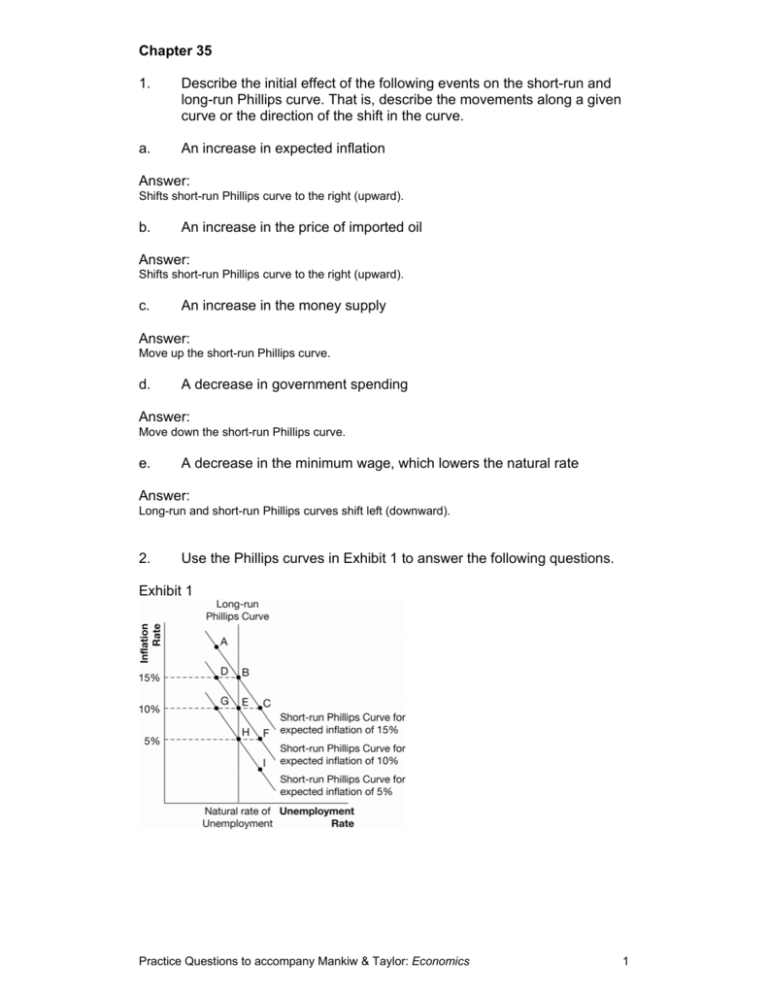
Chapter 35 1. Describe the initial effect of the following events on the short-run and long-run Phillips curve. That is, describe the movements along a given curve or the direction of the shift in the curve. a. An increase in expected inflation Answer: Shifts short-run Phillips curve to the right (upward). b. An increase in the price of imported oil Answer: Shifts short-run Phillips curve to the right (upward). c. An increase in the money supply Answer: Move up the short-run Phillips curve. d. A decrease in government spending Answer: Move down the short-run Phillips curve. e. A decrease in the minimum wage, which lowers the natural rate Answer: Long-run and short-run Phillips curves shift left (downward). 2. Use the Phillips curves in Exhibit 1 to answer the following questions. Exhibit 1 Practice Questions to accompany Mankiw & Taylor: Economics 1 a. At what point is the economy located if people expect 10 per cent inflation and inflation actually is 10 per cent? Answer: E. b. Referring to (a) above, is unemployment above, below, or equal to the natural rate? Answer: Equal to the natural rate. c. At what point is the economy located if people expect 10 per cent inflation and the actual rate of inflation is 15 per cent? Answer: D. d. Suppose the economy is operating at point D. Over time, in which direction will people revise their expectations of inflation: up or down? Answer: Up. e. Suppose the economy is operating at point D. As people revise their expectations of inflation, in which direction will the short-run Phillips curve shift-right or left? Answer: Right. f. Suppose the economy is operating at point E. In the short run, a sudden decrease in aggregate demand will move the economy toward which point? Answer: F. g. Suppose the economy is operating at point E. In the long run, a decrease in government spending will tend to move the economy toward which point? Answer: H. h. Suppose people expect 5 per cent inflation. If inflation actually ends up being 10 per cent, in which direction will unemployment move: above or below the natural rate? Answer: Below the natural rate. Practice Questions to accompany Mankiw & Taylor: Economics 2 3. Use a Phillips curve graph to answer the following questions. Assume the economy is initially in long-run equilibrium. a. What happens to an economy’s unemployment and inflation rate in the short run if the central bank increases the growth rate of the money supply? Answer: Inflation increases, unemployment decreases. b. What happens to an economy’s unemployment and inflation rate in the long run if the central bank increases the growth rate of the money supply? Answer: Inflation increases, unemployment stays at the natural rate. c. Can printing money keep unemployment below the natural rate? Explain. Answer: No. Unemployment temporarily decreases, but as people grow to expect the higher inflation, unemployment returns to the natural rate. d. What is the end result of a central bank repeatedly attempting to hold unemployment below the natural rate with expansionary monetary policy? Explain. Answer: Continued attempts to move unemployment below the natural rate simply causes inflation. 4. Suppose the economy is operating at the natural rate of unemployment with a high rate of inflation (point A in Exhibit 2). Suppose the central bank announces a sudden monetary contraction to reduce inflation. Shown below are two possible paths the economy might take to adjust to the new lower rate of money growth. Choose the path that best depicts what might happen in each of the following cases and explain your reasoning. Exhibit 2 Practice Questions to accompany Mankiw & Taylor: Economics 3 a. The central bank’s announcement is not believed. Answer: Economy moves from A to B because people fail to reduce their price expectations and wage demands, so unemployment rises as inflation falls. b. The central bank’s announcement is believed and expectations of inflation are adjusted quickly. Answer: Economy moves from A to C because people reduce their prices and wages proportionately. c. The central bank’s announcement is believed but all workers have long-term wage contracts that cannot be renegotiated. Answer: Economy moves from A to B because people are unable to actually reduce some of their wages and prices, so unemployment rises as inflation falls. d. Which of the above cases (a, b, or c) best describes what would happen if, in the past, the central bank had repeatedly announced that inflation was its number one priority, but it had failed to actually engage in the threatened monetary contraction? Why? Answer: Case (a), because people are rational to distrust a policy maker that has previously been untruthful. Practice Questions to accompany Mankiw & Taylor: Economics 4


